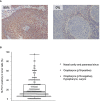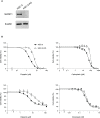Schlafen family member 11 indicates favorable prognosis of patients with head and neck cancer following platinum-based chemoradiotherapy
- PMID: 36741698
- PMCID: PMC9892834
- DOI: 10.3389/fonc.2022.978875
Schlafen family member 11 indicates favorable prognosis of patients with head and neck cancer following platinum-based chemoradiotherapy
Abstract
Recently, Schlafen family member 11 (SLFN11) has been reported to increase the sensitivity of cancer cells to DNA-damaging agents, including platinum derivatives; thus, SLFN11 may be a predictive biomarker for platinum-based chemoradiotherapy (CRT). In this study, we examined whether SLFN11 expression was associated with the therapeutic outcome of platinum-based CRT in head and neck squamous cell carcinoma (HNSCC). We performed immunohistochemical analyses for SLFN11 expression in 161 HNSCC tissues from patients who had been administered cisplatin-based CRT and examined the correlation between SLFN11 expression and progression-free survival (PFS). Additionally, SLFN11 expression was examined in 10 paired samples obtained before and after CRT in patients with local failure. Furthermore, in vitro experiments were performed using several HNSCC cell lines and isogenic SLFN11-knockout cells to assess the association between SLFN11 expression and drug sensitivity. PFS was found to be significantly better in the SLFN11-positive group than in the SLFN11-negative group among the 161 patients (5-year PFS: 78.8% vs. 52.8%, respectively, p < 0.001). Similar results were observed for the PFS at each primary site. The percentage of SLFN11 positivity was lower in tumor samples from patients with local failure after CRT than that in the corresponding primary tumors before CRT in 8 of 10 cases. Results of the in vitro assay demonstrated that SLFN11-knockout cells exhibited reduced sensitivity to DNA-damaging agents but not to the non-DNA-damaging agent docetaxel. Our findings suggest that SLFN11 may serve as a potential biomarker for predicting the response of HNSCC patients to platinum-based CRT.
Keywords: Schlafen family member; head and neck squamous cell carcinoma; immunohistochemistry; platinum-based chemoradiotherapy; prognostic marker.
Copyright © 2023 Hamada, Kano, Murai, Suzuki, Tsushima, Mizumachi, Suzuki, Takashima, Taniyama, Sakamoto, Fujioka, Ohba and Homma.
Conflict of interest statement
The authors declare that the research was conducted in the absence of any commercial or financial relationships that could be construed as a potential conflict of interest.
Figures




Similar articles
-
Prognostic impact of Schlafen 11 in bladder cancer patients treated with platinum-based chemotherapy.Cancer Sci. 2022 Feb;113(2):784-795. doi: 10.1111/cas.15207. Epub 2021 Dec 7. Cancer Sci. 2022. PMID: 34808009 Free PMC article.
-
The first evidence for SLFN11 expression as an independent prognostic factor for patients with esophageal cancer after chemoradiotherapy.BMC Cancer. 2020 Nov 20;20(1):1123. doi: 10.1186/s12885-020-07574-x. BMC Cancer. 2020. PMID: 33218331 Free PMC article.
-
SLFN11 Expression in Advanced Prostate Cancer and Response to Platinum-based Chemotherapy.Mol Cancer Ther. 2020 May;19(5):1157-1164. doi: 10.1158/1535-7163.MCT-19-0926. Epub 2020 Mar 3. Mol Cancer Ther. 2020. PMID: 32127465 Free PMC article.
-
Schlafen 11 (SLFN11), a restriction factor for replicative stress induced by DNA-targeting anti-cancer therapies.Pharmacol Ther. 2019 Sep;201:94-102. doi: 10.1016/j.pharmthera.2019.05.009. Epub 2019 May 23. Pharmacol Ther. 2019. PMID: 31128155 Free PMC article. Review.
-
Can Schlafen 11 Help to Stratify Ovarian Cancer Patients Treated with DNA-Damaging Agents?Cancers (Basel). 2022 May 10;14(10):2353. doi: 10.3390/cancers14102353. Cancers (Basel). 2022. PMID: 35625957 Free PMC article. Review.
Cited by
-
The crucial role of single-stranded DNA binding in enhancing sensitivity to DNA-damaging agents for Schlafen 11 and Schlafen 13.iScience. 2023 Nov 23;26(12):108529. doi: 10.1016/j.isci.2023.108529. eCollection 2023 Dec 15. iScience. 2023. PMID: 38125019 Free PMC article.
-
SLFN11: a pan-cancer biomarker for DNA-targeted drugs sensitivity and therapeutic strategy guidance.Front Oncol. 2025 Jul 22;15:1582738. doi: 10.3389/fonc.2025.1582738. eCollection 2025. Front Oncol. 2025. PMID: 40766331 Free PMC article. Review.
-
Sexual Embodiment and Sexual Renegotiation Post-Cancer for LGBTQ People with a Cervix.Arch Sex Behav. 2025 Mar;54(3):1105-1120. doi: 10.1007/s10508-025-03090-w. Epub 2025 Mar 12. Arch Sex Behav. 2025. PMID: 40075053 Free PMC article.
-
SLFN11, far from being limited to responding to cancer DNA damage.Clin Exp Med. 2025 Aug 26;25(1):304. doi: 10.1007/s10238-025-01776-y. Clin Exp Med. 2025. PMID: 40856812 Free PMC article. Review.
-
MMR deficiency is frequent in colorectal carcinomas with diffuse SLFN11 immunostaining: clinicopathologic and molecular study of 31 cases identified among 3,300 tumors.J Pathol Clin Res. 2025 Mar;11(2):e70025. doi: 10.1002/2056-4538.70025. J Pathol Clin Res. 2025. PMID: 40105034 Free PMC article.
References
LinkOut - more resources
Full Text Sources
Research Materials

